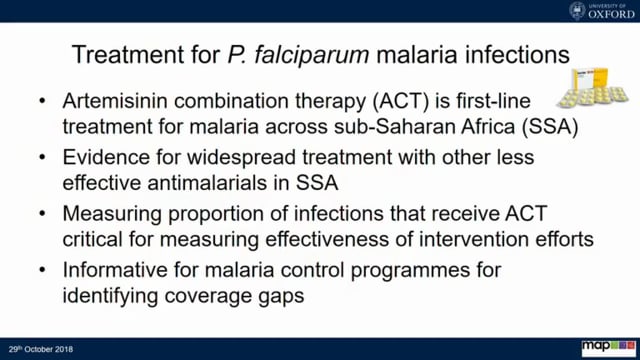ASTMH 2018, Ursula Dalrymple: “What proportion of malaria cases in African children receive effective treatment?”
Collaborator(s): University of Oxford, United Kingdom
Published: 29/10/2018
In collaboration with ASTMH, Image Audiovisuals, and session presenters, MESA brings you this webcast from the 67th ASTMH annual meeting in New Orleans, October 2018
Title: “What proportion of malaria cases in African children receive effective treatment?”
Speaker: Ursula Dalrymple, University of Oxford, Oxford, United Kingdom
Session information:
October 29, 2018, 10:15 AM – 12:00 PM, Marriott – Sheraton – Rodrigue Gallery (1st Floor)
Abstract:
Understanding the proportion of malaria infections that receive and adhere to effective treatment and are subsequently cured is vital for measuring progress in lowering the burden of malaria. Using household survey datasets for over 170,000 children over the past decade, we extract information on two-week malaria positivity and fever and treatment history. By coupling this data with a predictive model to distinguish between fevers attributable to malaria and fevers caused by non-malarial febrile illness (NMFI), we estimate the proportion of malaria infections that are removed from the surveyed population by effective treatment. Further, we estimate the proportion of malaria-positive fevers that would not be cured by effective treatment due to co-infections with NMFI, and estimate the rate of inappropriate treatment of NMFI with antimalarial medication. We quantify the proportion of individuals within the household surveys whose infections are not removed as an individual passes through each stage between infection and cure: i) their infection is asymptomatic, ii) they do not seek treatment, iii) they do not receive an antimalarial at the health facility they visit (and the proportion of individuals who receive a parasite-based diagnosis in-clinic), iv) they are non-adherent to the prescribed antimalarials, and v) the treatment fails. By adding quantitative information to the reasons why infections remain untreated, we measure the achievements of malaria interventions through time and identify coverage gaps where further interventions should be targeted.
THEMES: Drug-based Strategies | Surveillance | Vulnerable Populations


